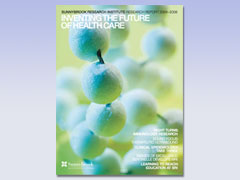Q&A
Rob Fowler is a critical care physician at Sunnybrook and an associate scientist at Sunnybrook Research Institute (SRI). In 2005, the Ontario Ministry of Health and Long-Term Care awarded him a career scientist award. This award recognizes promising scientists in the early stages of their careers.
Fowler's focus is on clinical epidemiology and outcomes for critically ill patients. In 2005, Annals of Internal Medicine published his study, Cost-Effectiveness of defending against bioterrorism: a comparison of vaccination and antibiotic prophylaxis against anthrax, in which he investigated the options for a metropolitan city facing a bioterrorism attack. Fowler spends about 75% of his time on research. Dropping a stethoscope and an empty chocolate milk carton on the table beside him, the 37-year-old shared his thoughts on the study, which included the work of researchers from Toronto, Stanford University, Duke University and the US Centers for Disease Control.
What's your interest in bioterrorism? There are limited resources to care for large numbers of patients who are critically ill or who have the potential to become critically ill. I want to look at what to do when health care systems are faced with more demand than they can supply. I was in California when 9-11 hit and when the anthrax scare was going through the States. After that, a lot of stakeholders in various levels of U.S. government started asking, "What if?"
What are the big bioterrorism threats? In the U.S., they are smallpox, anthrax, Yersinia pestis (the infectious agent of bubonic plague) and tularemia (a severe infectious bacterial disease). Anthrax can be aerosolized and you could potentially fly an airplane and douse a city with spores, which are extremely difficult to get rid of. It might sound farfetched, but with the things that happen these days, it's not so much.
What outcomes were you after? There were two. One is effects (lives and quality of life saved)and the other is cost. We had to put into this model both of these considerations to see what looked better.
What did you find? The strategy of vaccinating everybody in a population ahead of time doesn't make a lot of sense. You've got no anthrax and a portion of the people suffering side effects. And it costs a lot: hundreds of dollars per person over the course of the vaccination. (It takes six months to a year to fully inoculate someone.) So we determined that the most attractive strategy—the one associated with the greatest effects and the fewest costs—was to wait until an attack took place, then give the population preventive antibiotics very quickly, along with a vaccine.
Can we feel confident with this plan? Not at all. A lot hinges on a system's ability to handle a mass tragedy. If we go back to the SARS experience—and I was quarantined at Sunnybrook during that ordeal—clearly our health care system wasn't prepared. In the last three years, have we done a lot to try and prepare? Yes. But are we prepared? Absolutely not.
So what should we be doing? That's the question. It's very hard to justify preparing for very unlikely terrorist threats when they may never happen, and you end up diverting energy and funds from worthy near-term causes like AIDS, poverty and tuberculosis. I would say we should probably get into place a system where you could distribute vaccines for something like this in short order, an infrastructure that's pretty flexible.
What's appealing about this kind of research? From a mental-adrenaline perspective the idea that, in 2006, there are still lots of things out there that can wipe out big chunks of us in an instant, and the idea that our sense of security is at risk is, to me, interesting, exciting and potentially very important.
Fowler's work was funded by the University of Toronto, Sunnybrook Research Institute and the Department of Medicine at Sunnybrook Health Sciences Centre.
PDF / View full media release »





